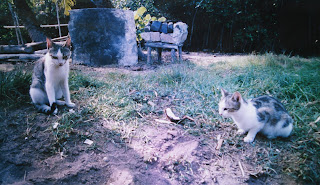Latest news from Fiji
In the last few days I have had an update on how things are going in Fiji, and on Yadua in particular.
First about the coup:
There doesn't appear to be much on news sites like the BBC on recent events, and in general nothing major has changed. The Army Commander (aka the Interim Prime Minister) is still in charge and has set no real plans for a return to democracy. Though the old President was returned to office his position is widely seen as only ceremonial, and he has no real powers.
Those who dissent, in public and in private, have been subjected to intimidation, including physical violence, by the Army. If you are interested in hearing some of the dissent then search for "Resist Frank's Coup" on the internet, and read some of the blogs.
Internationally, the EU has threatened to withdraw aid and other countries have warned against travel to the islands.
Within Fiji daily life, away from the threats of the Army, has remained largely unaffected, though the poorest families have suffered. Wage cuts, redundancies, rising costs and a general downturn in commerce hitting them most.
Secondly on Yadua:
The coup hasn't really had a big effect out there, and meanwhile the funds I raised have been put to good use.
The Development Committee has used it's 2,000FJD (and a 500FJD donation from Taronga Zoo in Sydney, Australia) to build a solar power generation and storage system for the Church and Community Hall. This paid for batteries, wiring systems, the switchboards and the lights, whilst the solar cells had originally been installed on the island for a different (and redundant) project.
Jone Niukula from the National Trust transported all the gear, his cousin designed the system and the actual set up work was done by a researcher working on Yadua Taba. Not forgetting of course the labour being paid for in donuts cooked by the Elesi!
The system was finished between last Christmas and New Years, with the lights first used in the Church for the New Years' Service. Apparently this was met with quite a lot of amusement, since the villagers were not used to silent electricity!
This is really good news, because now the village does not need to buy fuel from the mainland.
Meanwhile the Environment Committee are working on a couple of projects.
300FJD has been spent on 6 long range walkie talkies, to improve safety on crossings to the mainland. This was initiated when Anare's (the head of the Warrior Clan) boat sank, and the plan in future is for each village boat crossing to Bua to take one with them, with a second one in the village. Both would be switched on for the whole crossing.
In the meantime another family out fishing got into trouble, and, whilst I don't know the specifics, this stresses how important these will be for safety.
An incinerator has been approved by the village, though it has not been constructed yet. I am not sure how much this will cost.
Around 500FJD has been earmarked for environmental education for the children. All of the topics are actually covered in class, but due to a lack of time on the curriculum it was felt the children could learn more from extra-curricular activities.
One saturday a month, from April to November, the children of classes 5-8 will take part in short classes, excursions across the island and in the sea, talks with their elders and other activities, with the emphasis being on getting the children to report back on what they have done and learnt. They aim to cover topics from traditional wildlife knowledge through to simple biology and natural disasters.
The village and teachers are very supportive of these classes, so much so, in fact, that even some of the older villagers have expressed an interest in attending them!
On other news from Denimanu, government engineers are working on digging a borehole to supply the village with fresh water.




